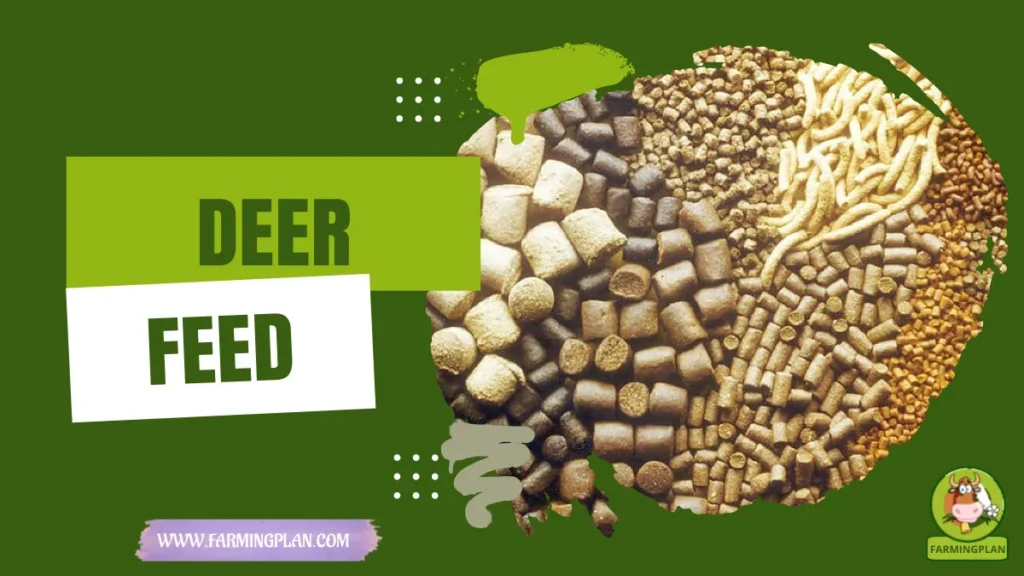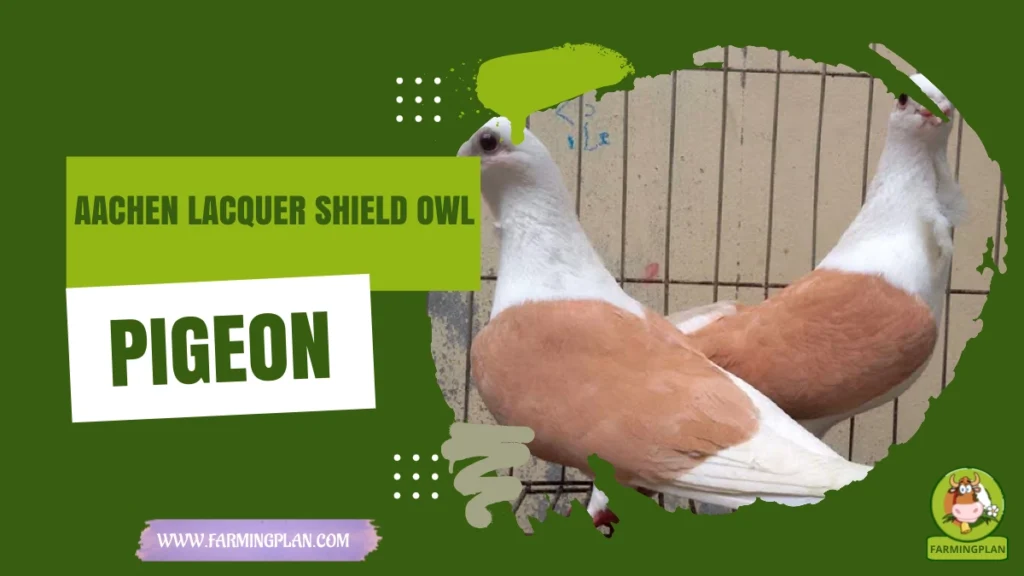I’ve spent years around horses, but there’s something different about the Chincoteague Pony Horse. Maybe it’s how they look straight at you with those clever eyes or the story that follows them—across oceans, shipwrecks, and into legend. If you’ve ever watched the Chincoteague Pony Horse Swim 2025 or dreamt of raising a pony that’s part wild and all heart, then you’re in for a treat. These ponies might be miniature, but their history, personality, and endurance are anything but. In this article, I’ll walk you through everything I know from experience—how they came to be, how to care for them, and why they make incredible companions for first-time owners and seasoned farmers.
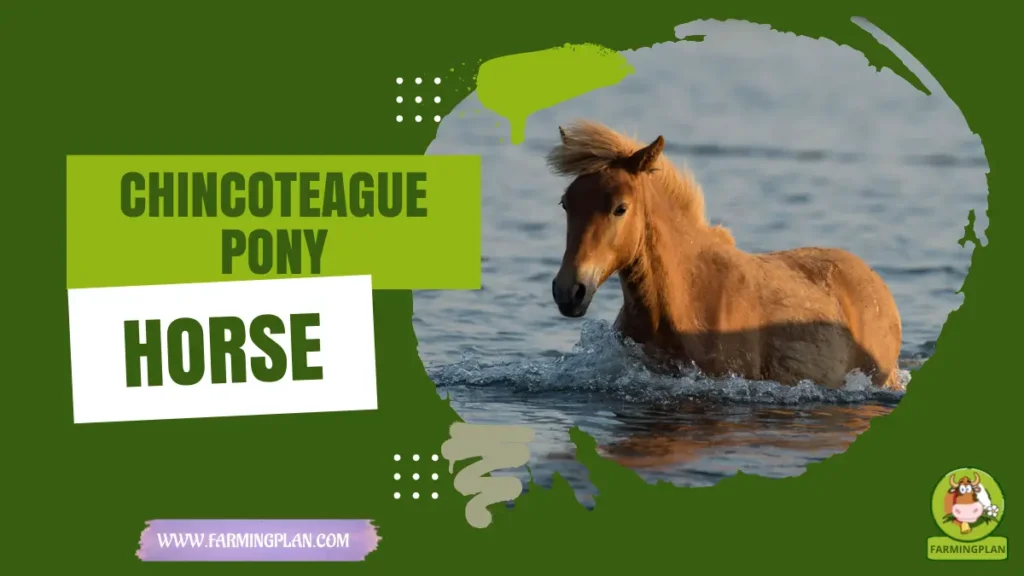
History & Origin of the Chincoteague Pony Horse
The Chincoteague Pony Horse roots stretch back to the 17th century. Legend says a Spanish galleon carrying horses sank off the coast, and those that survived swam to Assateague Island. Whether that’s fact or folklore, the result is real—hundreds of ponies adapted to the island’s challenging, salty environment.
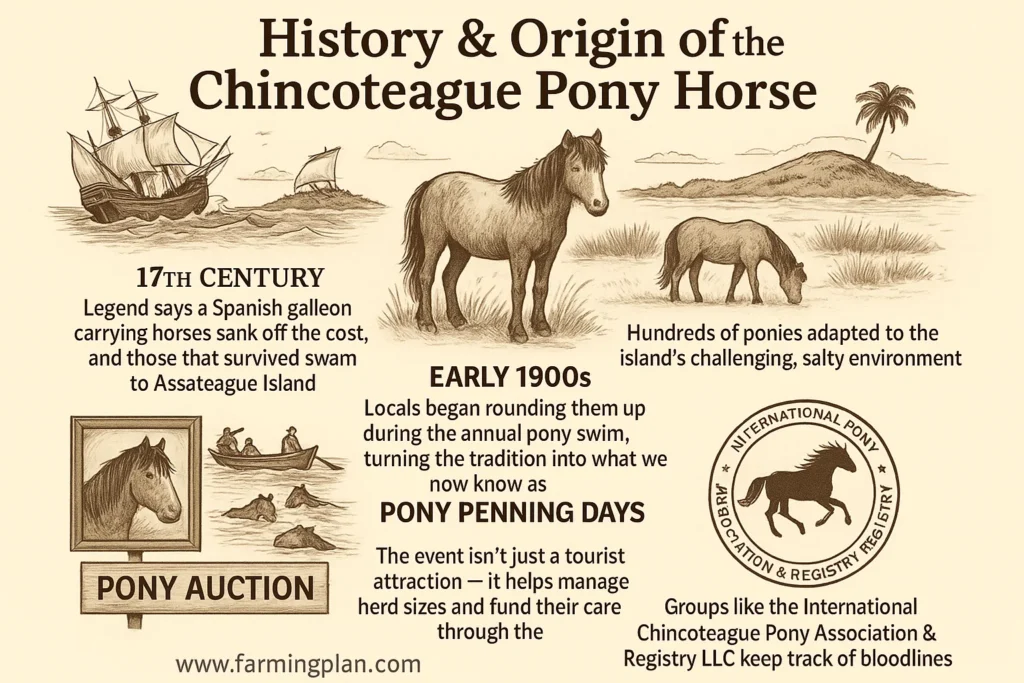
By the early 1900s, locals on Chincoteague Island began rounding them up during the annual pony swim, turning the tradition into what we now know as Pony Penning Days. The event isn’t just a tourist attraction—it helps manage herd sizes and fund their care through the PONY AUCTION. Groups like the International Chincoteague Pony Association & Registry LLC keep track of bloodlines, preserving their legacy. It’s wild to think that the shaggy ponies we see today are descended from horses that braved shipwrecks and storms.
Characteristics of the Chincoteague Pony Horse
Don’t let their size fool you—Chincoteague Pony Horse are hardy little beasts. On average, they stand around 12 to 13 hands tall. That’s roughly four feet at the shoulder. Despite their smaller size, they’ve got muscular builds, strong legs, and those thick winter coats that helped them survive icy coastal winds.
They come in almost every colour you can imagine—paint, palomino, chestnut, black, and more. Their manes and tails? Wild and thick, just like their spirits. Because of the harsh environment on Assateague Island, they’ve developed tough hooves and a high tolerance for poor conditions. Over time, the breed has been refined for domestic life, but if you adopt a Chincoteague Pony Horse, you’ll still see that raw, wild look in their eyes.
Read More: Connemara Pony Horse: Why This Gentle Breed Will Transform Your Riding Experience
Nature & Temperament of the Chincoteague Pony Horse
In the wild, these ponies are cautious. But once you bring one home and earn its trust, you’ll be amazed at how sweet and affectionate it can be. Mine would follow me around the pasture like a dog. They’re curious, independent, and smart—sometimes too innovative! So, training them takes patience, but once they bond with you, it’s for life.
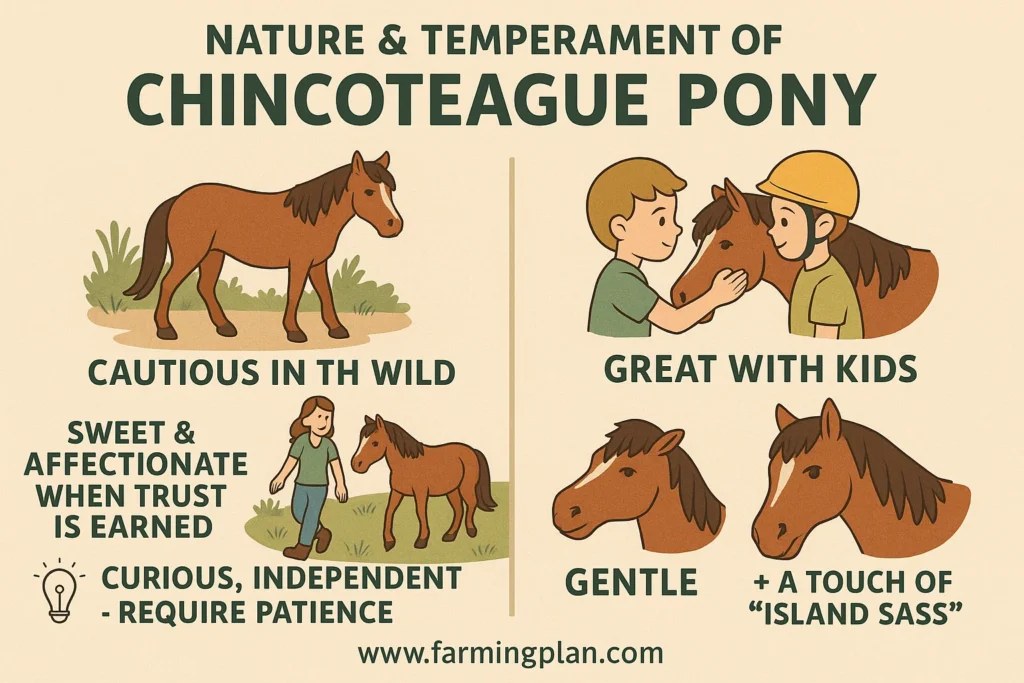
They’re great with kids, making them perfect for family farms or beginner riders. Their temperament leans gentle, though they’ve got a little island sass. You’ll know what I mean if you’ve raised other feral animals or stubborn farm pets. That wild side never entirely disappears; honestly, that’s part of their charm.
Food & Diet of the Chincoteague Pony Horse
In the wild, Chincoteague Pony Horse eat what they can find—American beachgrass, bayberry, and other coastal plants. They drink fresh water from ponds and adapt to a pretty rough diet. But when you bring one home, you’ve got to improve their menu.
I feed my high-quality hay, a bit of grain, and plenty of clean water. Too much sugar or starchy feed can cause health issues, mainly because these ponies are used to surviving on less. Salt blocks and a mineral supplement help fill in the gaps. And always watch for overfeeding. It’s easy to spoil them, but that leads to more problems than good. Their protein diet helps them grow and maintain that solid island muscle.
Usage & Purpose of the Chincoteague Pony Horse
People often ask if these ponies are just for show. Not at all. They make great companions, especially for kids. Some owners use them for light riding, trail work, and therapy. Their beautiful colour patterns and strong personalities make them popular in pony clubs and local shows. Every July, during the annual pony auction, folks from all over the country come to buy or adopt a Chincoteague Pony for sale. The event raises money for the fire department and ensures that unclaimed foals are well cared for. Some even become part of the buyback pony program, where they return to the island as breeders.

Special Features
These ponies are incredibly adaptable. They’ve survived hurricanes, droughts, and freezing winters. Their small size helps them navigate narrow trails and rocky beach paths, and their hooves are like iron. What makes them stand out, though, is their story. Every pony has a tale—from ancestors that roamed wild on Assateague Island to living legends adopted by loving families. I’ve even seen some ponies develop real emotional connections with their people. They remember faces and routines and even hold grudges (ask me how I know).
Read More: Welsh Pony Horse: The Unbeatable Combination of Strength and Gentle Temperament
Keeping Them Healthy: Common Health Issues & Prevention
Like any horse, Chincoteague Pony Horse can get sick if you’re not careful. One of the biggest concerns is infectious anaemia or swamp fever. That’s why yearly vet checkups and vaccinations are a must. Hoof care is another priority, especially if your pony doesn’t live on the sand like the island ones. To control overbreeding, wild herds are managed using contraceptive treatments—dart-administered by Park Rangers. In a domestic setting, you’ll want to keep your pony’s weight in check and provide shelter from wind and rain. Good grooming, proper feeding, and a strong bond go a long way in preventing health problems.
A Happy Pony Starts With A Loving Home, A Balanced Diet, And A Gentle Hand—Care For Them, And They’ll Give You A Lifetime Of Loyalty.
Pet Owner Guidelines: Caring for a Chincoteague Pony Horse
Learn how to correctly care for a Chincoteague Pony Horse—from building a safe home to feeding, grooming, and training. These step-by-step tips help pet owners raise happy, healthy ponies full of personality.
Step 1: Create a Safe Living Space
Chincoteague Pony Horse may be miniature, but they’re surprisingly resourceful—and excellent escape artists. Your priority should be building a secure, comfortable, and enriching environment. Start by setting up a fenced pasture using wooden boards or high-tensile wire. I recommend a height of at least 4 feet, though 4.5–5 feet is even better for younger, jumpier ponies. Double-check for any weak points—loose boards, gaps under the fencing, or open latches. If there’s a flaw, trust me, they’ll find it. Your pony will also need adequate shelter to protect them from harsh sun, rain, and cold winds.
A three-sided run-in shed allows them to come and go freely. Consider adding a windbreak or blankets during the snow season for colder regions. Shade trees are great bonuses, too. These ponies are social creatures—they’ve lived in herds their whole lives. So, if possible, keep them with at least one companion animal. Another horse or pony is ideal, but donkeys and goats make great barnyard buddies, too. I once had a Chincoteague that bonded with an old rescue goat—they’d nap together every afternoon like clockwork. Companionship reduces stress and keeps boredom (and naughty behaviour) at bay.
Step 2: Build a Balanced Diet
While wild Chincoteague Pony Horse survive on tough salt marsh grasses and shrubs, your pony will need a nutrient-rich but controlled diet. Start with quality grass hay, fed at around 1.5–2% of their body weight daily. That means a 600-pound pony should get 9 to 12 pounds of hay daily. Timothy, orchard, or Bermuda hay are all excellent choices. If your pony is in regular training, underweight, or nursing, add a small amount of grain or pelleted feed—but go light on it. Their metabolism is efficient, and too much sugar or starch can lead to health issues like laminitis. Avoid sugary treats like molasses-coated feeds or too many apples and carrots. Keep snacks healthy and occasional.
Fresh, clean water is non-negotiable. In hot weather, ponies drink a lot more than you’d expect. I check my troughs at least three times a day in summer and twice a day in winter to break ice or top off water levels. Add a loose mineral supplement or salt block to ensure they get trace elements their hay might lack. A good diet is the foundation of a happy, healthy pony.
Step 3: Keep Up with Grooming
Grooming is about more than just looking good—it’s a key part of pony care that keeps their coat, skin, and hooves healthy while building your bond. Chincoteague Pony Horse grow thick winter coats, especially if they’ve spent time outdoors, so regular grooming helps avoid matting, dirt buildup, and skin issues. Start with a curry comb to loosen dirt and hair, then move on to a soft body brush for sensitive areas like the face and legs. Finish with a hoof pick, cleaning out all four hooves daily, especially if your pony has been walking through wet, muddy, or rocky areas. I also keep a detangler spray on hand for their thick manes and tails.
Watch for rain rot, lice, ticks, or skin irritation—particularly during wet seasons or humid climates. Bathe them only when needed (or if they’ve rolled in something unspeakable), but even a rinse-down after a dusty day feels good. And don’t forget, grooming time is bonding time. Many ponies grow to love it—I know mine melts when I brush behind her ears.
Step 4: Schedule Regular Health Care
Caring for a Chincoteague Pony Horse staying proactive with their health. Wild herds may rely on natural selection, but your pony deserves regular veterinary care. At a minimum, schedule two vet visits annually—spring and fall are good times for wellness checks, vaccinations, and deworming. Dental health often gets overlooked but is essential. Ponies’ teeth grow throughout their lives, and uneven wear can lead to sharp points or chewing problems. A dental float once a year will keep them eating comfortably.
Farrier visits are just as important. Even if your pony doesn’t wear shoes, you must trim hooves every 6–8 weeks. Overgrown or cracked hooves can cause lameness fast. I keep a basic first aid kit stocked with bandages, wound spray, antiseptic, and a thermometer—just in case. Learn how to take your pony’s temperature and pulse; it could save precious time in an emergency.
Step 5: Train with Patience and Love
Training a Chincoteague Pony Horse is one of the most rewarding parts of ownership—but don’t expect overnight results. These ponies are intelligent, independent, and a little stubborn (in the cutest way). Use positive reinforcement like treats, calm praise, and repetition. Keep lessons short—10 to 15 minutes max—and always end on a win. Start with basic groundwork: leading, standing tied, haltering, and picking up feet. Once they’re comfortable with you, introduce more advanced cues like lunging, loading into a trailer, or light riding. They thrive on routine and consistency, so they work in the same area when possible at the same time of day.
Never use force or loud scolding—it only builds resistance. I once spent two weeks teaching a young filly to trust the lead rope. But once she got it? She followed me like a puppy. With love and patience, your pony will become a loyal, responsive partner with which you’ll never want to part.
Read More: Fjord Horse: The Untold Truth Behind This Mighty Yet Gentle Breed
Expert Tips & Best Practices for Happy Ponies
- Let them roam when possible. Grazing keeps them calm and healthy.
- Never rush training. These ponies are thinkers, not followers.
- Hoof care is everything. Check weekly and trim often.
- Visit Chincoteague, Virginia, and learn from locals.
- Keep their living space fun—logs to jump, buckets to knock over (yes, they will).
FAQ
How much does a Chincoteague Pony Horse cost?
A healthy Chincoteague Pony Horse can cost between $1,000 and $5,000, depending on age and training. Prices often rise during auctions.
Is the Chincoteague Pony Swim 2025 cruel?
Not at all. Vets and rangers monitor it, and the ponies are guided gently and safely across the channel.
Where can I find a Chincoteague Pony for sale?
Check the annual pony auction during Pony Penning Days or through registered breeders listed by official pony associations.
What size are Chincoteague ponies?
They typically stand 12–13 hands high (around 48–52 inches) and are sturdy for their size.
Are Chincoteague ponies good for kids?
They’re gentle, friendly, and love attention—great for young riders or families new to horses.
Conclusion
The Chincoteague Pony Horse is a history wrapped in a shaggy, lovable package. These ponies may come from wild beginnings, but they become loyal friends and hardworking farm companions with the proper care. From their legendary swim to their playful spirit, they’ve captured the hearts of families and farmers for generations. If you’re considering bringing one home, trust me—it’s more than worth it. Just be ready to fall in love.

